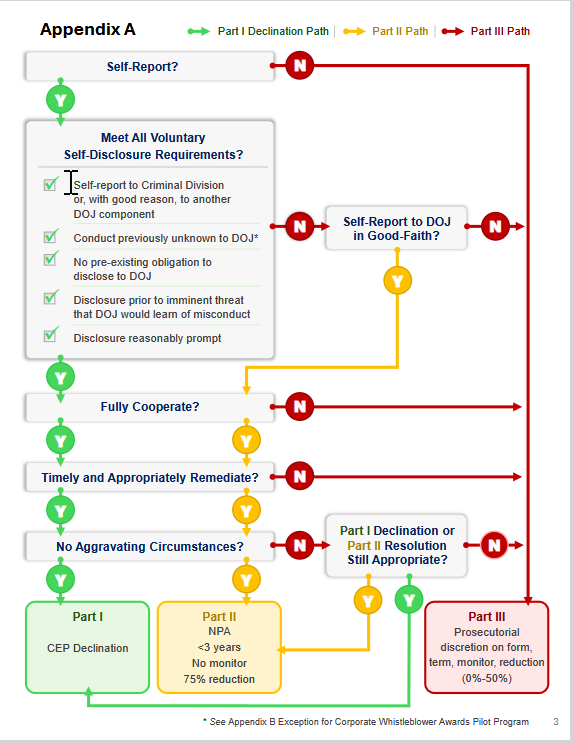Earlier this week, the Department of Justice’s Criminal Division released four documents on corporate misconduct, whistleblowers, compliance monitors, and enforcement priorities that outline significant changes to the DOJ’s policies under the Trump Administration. These four documents are:
- Updated CEP (Corporate Enforcement and Voluntary Self-Disclosure Policy)
- Focus, Fairness, and Efficiency in the Fight Against White-Collar Crime
- Selection of Monitors in Criminal Division Matters
- Revised Whistleblower Awards Pilot Program
As noted in this speech by the new head of the Criminal Division – Matthew Galeotti – the principal thrust is that the DOJ aims to incentivize self-reporting by providing clearer benefits for those that are prompt in their disclosure – although the self-reporting framework itself is slightly complex. This is part of a shift toward providing increased benefits to companies generally – although note that the Whistleblower Awards Pilot Program has been expanded to include six additional types of conduct.
In deciding whether to self-report, companies will still want to consider the risks of follow-on lawsuits and possible reputational damage. Despite the DOJ’s more limited resources, these realigned priorities shouldn’t be viewed as a reason to not be as vigilant in how you comply with the law, including the strength of the controls – and whistleblower program – you have in place. In addition, the increased clarity and focus of the DOJ’s policy may mean that the agency has less patience for delays.
Enhanced Self-Reporting Incentives
- The updated CEP changes the previous “presumption” of declination to a promised declination if requirements are met
- Companies can receive full self-reporting credit even if a whistleblower contacts DOJ first (preserves a 120-day safe harbor grace period)
- Four requirements for declination: voluntary disclosure, full cooperation, timely remediation and no aggravating circumstances
- Companies still must pay disgorgement/forfeiture and restitution/victim compensation
- The self-reporting calculus remains complex due to required payments, public declinations and potential actions from other agencies
- The updated CEP includes a flow chart for the first time as an appendix (see below)
“Near Miss” Self-Disclosure Benefits
- Companies that self-report in good faith but don’t qualify for declination can still receive:
- A more lenient non-prosecution agreement
- A term length under three years
- No independent compliance monitor
- A 75% reduction off the low end of the fine range under the DOJ’s guidelines
New Enforcement Priorities
- Focus on crimes against US taxpayers, investors, customers, and national security interests
- Ten “high-impact areas” including investor fraud, trade fraud, money laundering and national security threats that span multiple industries
- Broadened whistleblower program adds new eligible areas: corporate violations of federal immigration law, trade/tariff/customs fraud, and procurement fraud
Revised Monitorship Approach
- More tailored criteria for selecting monitors
- Four factors for determining if a monitor is necessary: severity of conduct, other government oversight, compliance program efficacy and the company’s control maturity
- Monitor costs must be proportionate to the criminal conduct, company profits and size/risk profile
- Tri-partite meetings required between company, monitor and government
- Review of existing monitorships to potentially narrow scope or terminate, where appropriate

Authored by

Broc Romanek